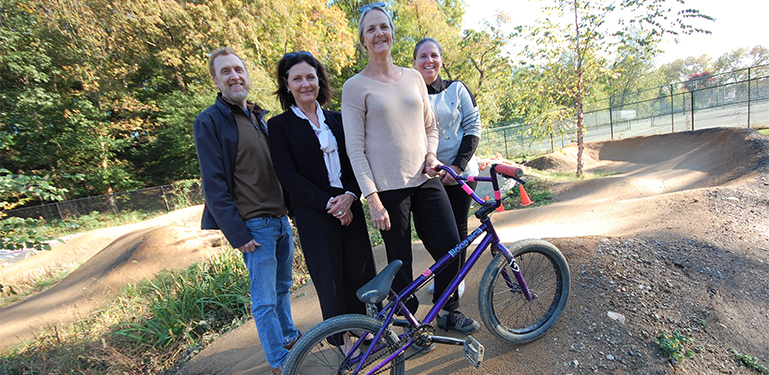
Michael Kasama has been a BMX rider for 23 years. Over that time, he’s had at least 10 diagnosed concussions and many more that weren’t, he estimates.
“For my generation, it wasn’t cool to wear a helmet,” Kasama says. “We suffered from a lack of foresight, I guess you could say.”
Kasama says he experiences severe memory loss and mood swings. He’s also begun to see other BMX riders he’s close with experience mental health issues, including depression. None of them understood what was going on, he says, until the stories of former NFL players suffering from chronic traumatic encephalopathy (CTE) began coming to light.
“Then we started connecting the dots with these symptoms,” he says. “And I began to get pretty concerned about the long-term effects of these injuries.”
The death of Dave Mirra, perhaps the sport’s highest-profile star, forced everyone to acknowledge that CTE was more than a football problem. In May 2016, two months after Mirra, 41, died by suicide, he was diagnosed with CTE.
“Michael and I started talking about the natural chilling effect his death had on the sport. People became keenly more aware of the helmet they were wearing, whether it was certified, as well as the past riding they’d done and the riding they planned to do,” says Heidi Grunwald, PhD, Managing Director of the Institute for Survey Research at Temple University and the Deputy Director of the Public Health Law Research Program at Temple’s Beasley School of Law. She’s also a seasoned mountain biker and one of the founders of Philly Pumptrack, a nonprofit BMX park in West Philadelphia. (Kasama is a member of its board of directors.)
Around the same time, Grunwald approached Dianne Langford, PhD, Professor of Neuroscience and the Assistant Dean of Research at the Lewis Katz School of Medicine (LKSOM), and said she wanted to learn more about the current state of the science around concussions. That conversation became the seed for Dr. Langford’s first study of BMX riders and head trauma, which was submitted for publication this month.
Over the last five years, Dr. Langford and her research team have studied concussions and subconcussive impacts among Temple’s athletes at great length. A subconcussive impact is one where the brain is shaken, but not violently enough to cause symptoms. However, the accumulation of these hits is believed to play as much of a role, if not more of one, in the development of CTE as concussions.
“Most of the time, there aren’t any signs or symptoms, so the player will continue playing. But in doing so, they’ll sustain even more subconcussive impacts and increase the risk,” Dr. Langford says. “It’s been reported that a college football player may sustain nearly 1,000 subconcussive impacts during a single season. Heidi wanted to see if the same thing was going on with BMX riders.”
With the help Dr. Grunwald, Kasama, and a multidisciplinary team from LKSOM, Dr. Langford tracked about 20 riders at Catty Woods, a famed BMX park near the Lehigh Valley International Airport, throughout 2017 and 2018.
Before and after riders went out onto the track, their blood was collected, their vision and balance were tested, and they were fitted with a mouthguard with an accelerometer, which measured the magnitude of head impacts and the direction of the force.
By measuring the riders before they rode, they essentially served as their own controls, Dr. Langford said. They were also measured against a group of riders at LKSOM who rode stationary bikes meant to mimic the intense riding and resting of the riders on the track, but without the jumping and landing.
The changes observed in the BMX riders’ blood biomarkers weren’t as dramatic as those Dr. Langford has observed in football players. “Which is a good thing for BMX riders,” she says. “In the normal course of riding—launching from a jump and landing without incident—it doesn’t appear that there’s as much of an impact as there is when a rider crashes or in contact sports. And the amount of change we did see could be related, in part, to an exercise effect.”
She’s planning a follow-up study that will attempt to determine whether any long-term effects stem directly from falls and concussions suffered while riding. In the meantime, she and Dr. Grunwald plan to share the results of the recently-completed study with riders at the Pumptrack.
“Right now, they just don’t know anything other than they’re seeing their friends suddenly struggle with depression,” Dr. Grunwald says. “Knowing something about the magnitude of brain impacts will help them understand the risks a little better so they can make informed decisions about their riding and that of their kids.”
A few months ago, Kasama, whose children are BMX riders, launched a Facebook group for BMX riders like himself who are concerned about concussions.
“A close friend had a manic episode, and I believe it was concussion-related,” he says. “Out of concern for him and, honestly, for ourselves, we started this group in the hope that it would just become a connection between people who have dealt/are dealing with these issues, free of any stigma. And if something’s not right, it’s somewhere they can turn for help.”
Photo caption: Pictured at the Philly Pumptrack BMX track in West Philadelphia are (l to r) Geoff Wright, PhD, Associate Professor of Physical Therapy and Bioengineering at Temple University; Dianne Langford, PhD; Heidi Grunwald, PhD; and Jane McDevitt, PhD, Assistant Professor of Kinesiology at Temple University.
